
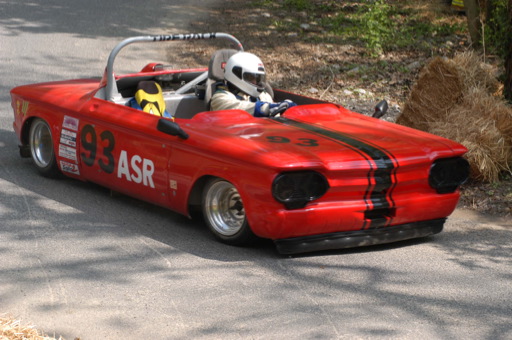
Image courtesy Warren Leveque.
Owner: Warren LeVequeThis is Warren's latest iteration of a purpose built competition car, he wrote the following history for FastVair and I've added some additional notes and photos.
Velocirapter

This car was a project that actually started with my son Michael and I building the "Velocirapter" Corvair powered open wheel formula car. This car was essentially a B Modified Formula Atlanta/Formula 5000 with a naturally aspirated Corvair drivetrain. A later Paxton Supercharger put it hopelessly in the unlimited A Modified class.
In all cases a reversed engine was used after a reverse ring and pinion failed immediately. The reversed engine was ultimately a necessity anyway because of the supercharger direction of rotation. Once again the short 80 inch wheelbase and very low polar moment made it nearly undriveable at high speeds for this average driver; Michael didn't seem to have any trouble at all.
Many of the lessons we learned, such as extending the wheelbase from 80" to 92", made it more drivable and ultimately faster. Moving weight forward also made it faster. Moving the battery just a foot forward to the very nose greatly improved the turn in. Weight was 1150# in a 1100# class. It now has huge wings, 92" wheelbase, and a 2900cc 13/1 engine and Randy Billingsley owns it.

For a short time I had a powerglide (right side up) in the open wheeler in order to get my wife to drive it. We simplly ran it in reverse gear (1.82:1) which is the same as second in a three speed manual. I had a high stall torque converter to help in the slaloms. It would do 70 in reverse at 6500 rpm which is plenty for most autoctrosses. I also baffled the PG oil pan so that it would work in hard corners.
At an unusually fast autocoss the large planetary reverse gear exploded and tore up the wing, tires, and exhaust. After that I simply ran a 3.27 4 speed, took off in 2nd and never shifted. Same as an automatic and the wife was fine with it.
LeFiat Spyder

The next car was Corvair components in a Fiat 850 Spyder body. This was to experiment with different engine configurations, as engines are unlimited in SCCA's E Modified autocross category and to have a passenger seat for "victims or babes". The Paxton Superchager was installed on the Corvair engine at this time.
The transaxle is not a powerglide now, but I had one in the Fiat body for a while. It was upside down with an extra tank/pan on the new bottom with a pump to bring the fluid up to the top/old pan.
At last, the Ultimate Spyder
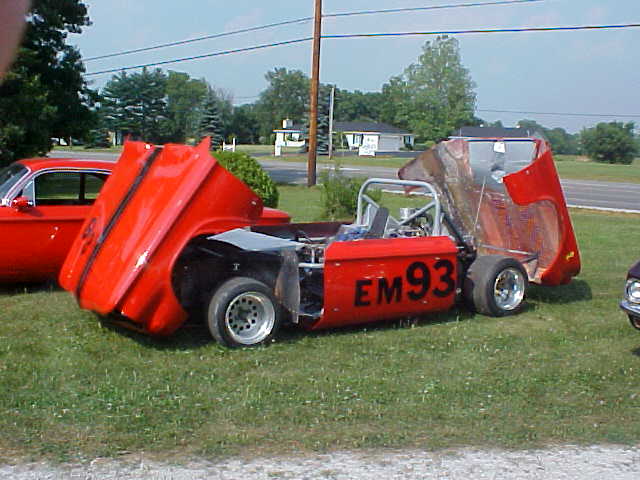
I had always wanted a small "Corvair looking" car to run in autocross events where large size is a big disadvantage. The Stinger - although I love it greatly - is a serious "PIG" on small courses. I had saved an old early convertible to use for this purpose, but decided it was just too heavy to start with; so just started anew with a tube frame replica. I purchased all of the available commercial repair parts for a fiberglass body and made all of the rest from molds off of a junk 64 Corvair.
Since I wanted the car to be short and still be "Corvair" related, I chose a 95" FC wheelbase. All models of Corvairs were listed on the same line in the modified rule book
. The mid engined Fiat was just large enough for me, the Roadster will seat anyone. In order to give the car proper proportions, it was sectioned in 3 places: 8" between the rear of the hood and the dash humps, 13" between the rear of the door and the rear wheelwell, and 9" behind the rear wheelwell, for 30" shorter overall. The over all width was kept at a totally stock 68 inches. When using a tube frame and all Formula car type fabricated suspension and axles it was possible to put 13 x 10" wide wheels under the front and 15 x 13" wide wheels under the rear - no flares - but tubbed. With similar wheels on the Stinger, the width is 73". On all of these three cars both Paxtons and Turbos were tried; the driveability just wasn't there for a short, light car. SCCA minimum weight at the time for EM was 1500#. The car came it at 1488# so it was ballasted up with lead in the front. From my previous driveability experiments I moved everything possible toward the nose of the car; battery, fuel tank, oil filter, oil cooler, fuel pump, and the driver.
The Roadster has a huge air scoop behind the seats which is ducted to the engine. The car has a front air dam and ground dragging air dam just in front of the mid engine, to keep positive pressure from under the car interfering with the cooling. A no-fan system was adequate for autocrosses and marginal for track events, so a half speed, full size Corvair fan was added when the Roots type supercharger was placed over the fan inlet.
The rules at the time required metal doors and an original floor and rocker panels, so those parts appear very stock. Mid engine cars are very hard to work on so both halves of the car open up like a giant clam shell. The driver sits one inch from the center of the car and the steering wheel is moved also. Steering is Porsche rack and pinion. The engine is centered and the suspension made to accommodate that. The pedals and brakes were donated from the earlier Fiat. The brakes were barely adequate for track events so when SCCA again changed the rules requiring me to further ballast the car I decided to do it with larger brakes and a bigger supercharger. Unfortunately this type of ballast is not quickly removeable.
The brakes now are Cavalier fronts with aluminum hubs and S-10 rears with aluminum calipers. I chose these to still be able to run 13" dia. wheels if desired and to have less rotor and wheel/tire flywheel effect. I will always believe that the best way to improve braking is to lighten the car and give the brakes less work to do. I did try adding the extra ballast exactly in the polar moment center of the car as per all of the experts on the various performance chat groups recommended. It turned in worse so I moved it forward as usual. I will have to say that all of this forward weight (45/55 whether or not I'm in it) makes it a terrible drag racing car.
The suspension is typical formula car with quite short A arms on the front due to the driver being forward between the wheels. The rear is typical formula car with multilinks (8 by my count) with a very low roll center. Antiroll bars on both ends (rear adjustable). The shocks are Aluminum double adj. Koni coil overs.
The engine is a reversed 3100cc (94mm) with 9 to 1 compression and a 6 tube intake. The Blower is from a 3800 cc Buick, the M 60 model, making about 8 psi max and using maybe a tenth of the horsepower to drive the Paxton. Of course the intake system had to be totally fabricated. The alignment of the blower drive system was the hardest task. The cam is a mild 280 adv. Crower. As with any blown engine, engine crankcase breathers abound. Flywheel is a scalloped Dale. Clutch is hydraulic for simplicity. I can't even glance at the tach so use a shift light and rpm limiter. Distributor is an S-10 HEI. Plugs are platinum. Spark is about 26 deg. total advance.
Currently the carburetor is a 45 DCOE progressive placed where the throttle body would be. A smaller carb was tried but went sonic and dead rich. Due to the mid engine complexity, the throttle is hydraulic. I don't have the patience for injections after all of the failed ones I tried.
Various transmissions have been tried, including, Yenko, and a special autocross only box. Since the low end torque is so great, a standard Saginaw with a 327 4 spider axle works fine for all uses.
The boost is always available, constant and boring compared to the exponential rush (and drivability problems) of centrifugal blowers. It just feels like a larger engine. But, since SCCA has allowed any engine whatsoever in EM with only a 100 # penalty, the Roadster is still not very nationally competitive, but great fun.
Warren
| Click on an image to see the full size version. | |
|---|---|
 |
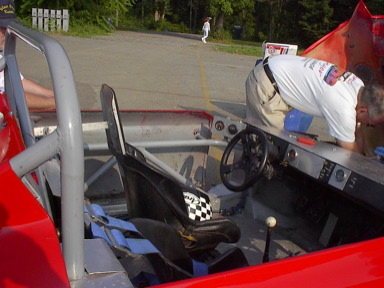 |
BTW, if you look closely at the back of Warren's race cars, you'll see:
Corinthians 9:24
From the Contemporary English Version of the Bible:
You know that many runners enter a race, and only one of them wins the prize. So run to win!
Here's some more detail when Warren changed the supercharger to a Roots type blower:
The positive displacement roots type blower is from a Buick 3800 SC. It is the smaller of the two blowers available and designed for higher RPM. I had to fabricate every thing. The only thing that was close was the Corvair displacement of 3100cc.
I used the power steering pulley and idlers from the turbo Pontiac GP in my back yard. The crank drive pulley was too large for the space in my engine between fan drive belts. The belt alignment was the largest job, the serpentine belt must be very precisely aligned with the crank pulley. There is no surface relative to the blower. Many turn buckles and rod end links had to be used.
It seems to work fine now after a disastous first attempt, in public of course. The postive displacement, linear boost, is in the range of 6 to 10 psi averaging about 8 psi. Boost is instaneous and drivability is great. This is just fine for a 10/1 comp engine.
This is the best this engine has run in 8 years of trying. Now it's worn out and will get a complete rebuild; especially since the cam gear is now gone. I attribute the good running to the less horsepower required to drive the blower. I would estimate about 20 hp used for the Paxton and less than 5hp. for the Roots type. The Paxton sheared belts under quick engine acceleration. I tried a Turbo also this year, but the drivability was terrible for a small, light car in autocrosses -- would have beeen great on a race track.
I made a 45 DCOE Weber out of a 40 DCOE and made it progressive for driveability. It mounts on the rear end of the blower where a throttle body would be and is completely contained under the flat body work. It is sooty rich now but runs great -- erred on the safe side.
I had to leave the engine reversed to accomadate the blower's rotation. Using the 1.4 boost factor this engine is equivalent to 4300 and still legal (4.5L max) for the lower weight in E Modified. With a 3.27 axle and 22" x 13,10" wide slicks I now take off and run in 2nd gear. I had to add weight for the new EM rules so the weight might as well make power.
I can't believe at this Senior citizen point in my life that I'm this excited about a project.
Warren
| Click on an image to see the full size version. | |
|---|---|
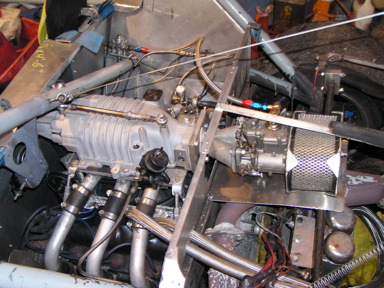 |
 |
 |
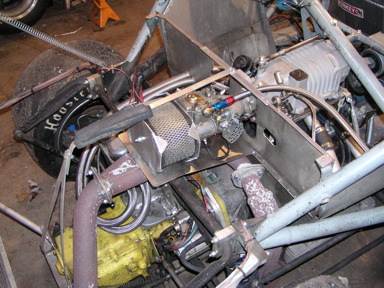 |
 |
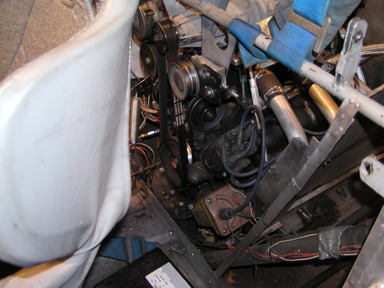 |
Images courtesy Warren Leveque.